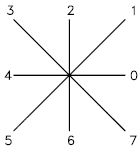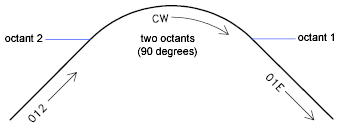
|
|

|

|
|

|
Special code 00A (or 10) uses the next two specification bytes to define an arc. This is called an octant arc because it spans one or more 45-degree octants, starting and ending on an octant boundary. Octants are numbered counterclockwise from the 3 o'clock position, as shown in the following illustration.

10,radius,(-)0SC
The radius can be any value from 1 through 255. The second specification byte indicates the direction of the arc (counterclockwise if positive, and clockwise if negative), its starting octant (s, a value from 0 through 7), and the number of octants it spans (c, a value from 0 through 7, in which 0 equals eight octants, or a full circle). You can use parentheses to improve readability. For example, consider the following fragment of a shape definition:
...012,10,(1,-032),01E,...
This code draws a one-unit vector up and to the right, a clockwise arc from octant 3 (with a radius of one unit for two octants), and then a one-unit vector down and to the right, as shown in the following illustration.



